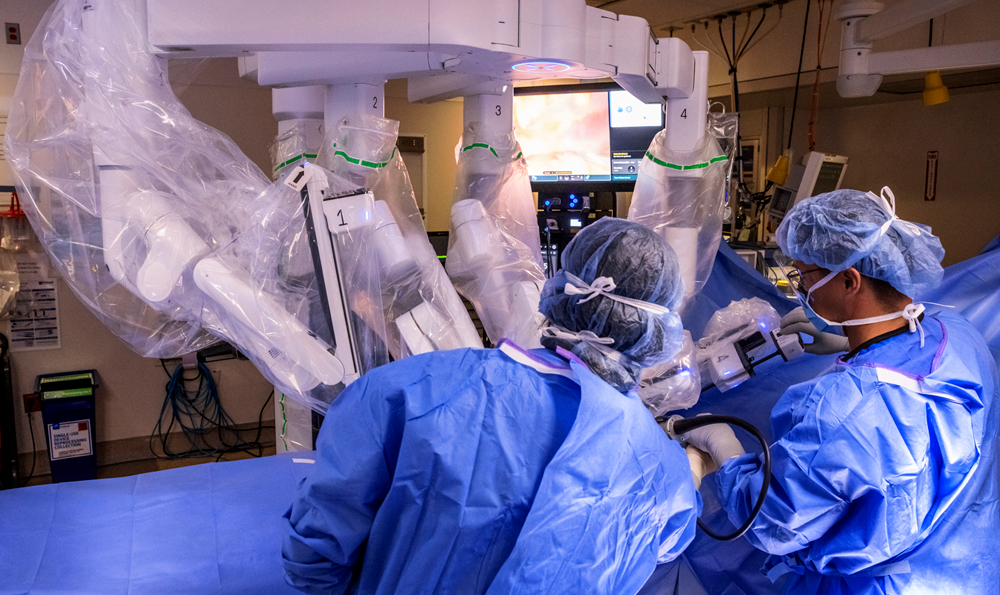Robotic surgery isn’t new. In fact, robot-assisted surgery has been used for decades in the United States. The technology is always improving, which is excellent news for patients. Modern advances mean patients are seeing better results with new surgical technologies. Recovery after surgery is getting faster and easier.
Muhammad Feteiha, MD, a bariatric and general surgeon with Atlantic Health who serves as the chairman of surgery at Atlantic Health Overlook Medical Center, notes that robotic surgery helps the patient because open surgeries, such as colon, cancer and hernia procedures, can now be performed robotically.
“Over the last 20 years,” Dr. Feteiha says, “we have had large advances in [all types of] minimally invasive surgery. However, robotic surgery now allows us to operate on a wider variety of cases that could only be performed in an open fashion.”
“We’ve had robotic technology in surgery for a while now, but the most recent versions of robots are much better,” says Rolando Rolandelli, MD, a specialist in gastrointestinal (GI) and colorectal surgery with Atlantic Health and serves as the chairman of surgery at Atlantic Health Morristown Medical Center. “The use of robotics allows the surgeon to more safely reach deep parts of the body, such as the pelvis and the diaphragmatic area.”
The surgeon is always in control
It’s important to know that robots don’t perform the surgery. A board-certified surgeon who’s highly trained and experienced is always in control. The surgical robot allows the surgeon to have extreme precision. “This may be in the form of navigational tools, operative field magnification or articulating instruments that allow access to hard-to-reach spaces,” says Dr. Feteiha.
And since robotic arms are much smaller than human hands, they also lead to a less invasive procedure. When Atlantic Health surgeons can perform a surgical procedure in a minimally invasive way — called laparoscopic — they use smaller cuts instead of one large opening in the skin.
Benefits for patients — and physicians
Minimally invasive robotic surgery offers several great benefits for patients:
- Faster recovery
- Less scarring
- Less time under anesthesia
- Reduced pain
Robotics doesn’t just help patients. After years of performing in an operating room, many surgeons face fatigue and pain in the neck, shoulders and back. Robotics reduces strain on the surgeon’s body, preventing many of these problems.
Widespread use of robotics
Surgeons use robotics’ highly advanced technology in operating rooms for a wide variety of general and specialized surgeries. Surgical robots assist with procedures on nearly all parts of the human body — from gynecological, orthopedic and urological to heart, lung and gastrointestinal surgery.
Atlantic Health uses a variety of robotic systems designed for various types of surgeries, including the Stryker and Globus systems for orthopedic and spine surgeries, the Ion system by Intuitive for lung surgeries and the Zimmer ROSA® system for neurosurgery. Atlantic Health surgeons have performed nearly 8,000 abdominal and thoracic procedures to date with the da Vinci surgical system.
Says Dr. Feteiha, “As Department Chair, I have personally overseen the growth of the da Vinci system in utilization, especially in the field of hernia surgery. The system allows us to tackle hernias that were previously operated on in an open fashion. Now, a single 12-inch incision can be reduced to 4-6 quarter inch incisions, and patients will go home either the same day or the next day.”
The latest robotic technology
Robotics also leverages artificial intelligence (AI) in a way that has a profound effect on laparoscopic surgery. Utilized together, robotics and AI can help improve surgical planning, avoid predictive complications and enhance decision-making.
For example, says Dr. Feteiha, “Several of the robotic platforms incorporate patients’ X-rays to assist in identifying anatomy and where to make the most proper cut. This ultimately allows for smaller incisions and quicker recovery.
“Another example is the Globus robot,” Dr. Feteiha adds. “It uses CT scans of the spine to create a 3D model of the spine to plan incisions and the exact drill and screw locations. This eliminates some of the variations which come down to millimeters of difference.”
The 3D aspect is relatively new to surgical robots, and manufacturers continue to make progress in that area. These and other advances lead to improved patient safety and better outcomes.
“I’m very proud of the robotic surgery programs at Atlantic Health,” says Dr. Feteiha. “That includes our dedicated teams of nurses who are trained in robotic surgery to help our surgeons provide better patient care. And the robotic surgical procedures that aren’t being offered at other hospital systems. At the same time, we’re also serving as a training ground for leading-edge robotic surgical techniques. And we’re always striving to do more.”












